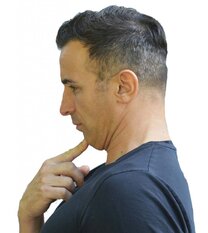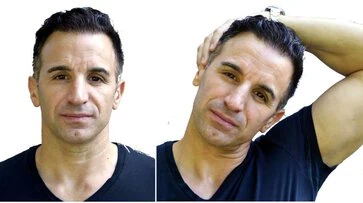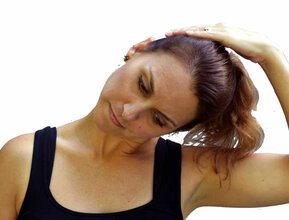Causes of Neck Pain
The neck has a tough job. Our heads weigh about 11 pounds, and supporting that bowling ball is the job of the neck. When the joints become misaligned, neck pain can result, but many different structures can be the cause of it.
- Muscles and ligaments are the most common tissues to be injured. Car accidents, prolonged poor posture, or just sleeping wrong can cause the neck muscles to hurt. Muscle pain usually feels like a soreness with some sharp, stabbing pain on movement. It can also feel like a bruise. Due to the anatomy of the neck, muscle injuries can cause pain to radiate in the upper back and the arms. Muscles can also go into spasm, where they contract uncontrollably. Spasm pain is severe, and when it hits can make you unable to move for a few seconds.
- Intervertebral disc injuries are less common, but more painful. Injuries to the discs can result from trauma, like a car accident, or repetitive wear, like degenerative arthritis. When the disc bulges or herniates in the neck, it often hits the nerve, causing pain down the arm into the hand.
- The spinal nerves that run down your arms start in your neck. Bulging discs, inflamed muscles or poor neck posture can irritate these nerves. Often called pinched nerves, this pain feels like burning or electrical pain, and can be accompanied by tingling or numbness in the arms and hands.
- The neck joints can be sprained like any other joint in the body. A sprained joint occurs when it moves past its normal range of motion. An injured joint feels like deep achy pain with very sharp pain when it moves in the wrong direction.
There are also rare, but serious causes for neck pain, like cancer, infections, or aneurysm. Chiropractors receive training to recognize these conditions and can send you to the right doctor for treatment.
Why do my neck muscles hurt?
Pain in the neck is most commonly from strains and sprains to the muscles and ligaments. Any joint or muscle can be injured when it is moved too quickly or beyond its capabilities. However, since the neck’s primary job is to hold your head up, forward head posture can also lead to neck pain.
This type of strain on the neck is becoming more and more prevalent with the constant use of technology. Overuse of laptop computers is one of the biggest causes of postural neck pain. A new condition called text neck, has been recently introduced to describe neck pain from too much looking at your phone.
Posture tips:
Draw a line straight down from your ears. Does the line run down the center of your shoulders? If not, you are using your muscles all day, every day to hold up your head. Improve your posture with exercises and adjustments to put more weight on your skeleton and off your muscles.
Read more about how to fix your Posture.
Sleeping Posture:

The way you hold your neck while sleeping can cause neck pain. No sleeping position is inherently problematic, but each position needs considerations to avoid problems.
How to Sleep to Avoid Neck Pain
- Side sleepers should use a thicker pillow, or two pillows to take up the space between neck and shoulder. They need extra support to keep your neck straight. A flat pillow often leads to side bending the neck all night or scrunching the shoulder to let the head rest.
- Back sleepers need a very flat pillow or no pillow to allow the head to rest without flexing the neck forward.
- Stomach sleepers should sleep on the edge of the pillow so the back of your head is a bit higher than the front. They need to avoid having their head turned 90 degrees all night.
Read more about the best way to sleep to avoid neck pain.
Whiplash
Whiplash generally occurs in a car accident, but any quick whipping neck motion can cause it. The extreme head motion, combined with the speed at which the neck flexes then extends, produces an injury that is worse than a standard neck sprain. Often the strain in the muscle occurs all along its length, and the overstretch nature of the injury can take longer to repair. Icing the muscles soon after the injury is important to limit the damage. Limit stretching in the early phases as the muscle is already overstretched.
Read more about Whiplash.
Treatments for Neck Pain
Home Care
When neck pain strikes, it can be debilitating. Driving, talking to someone, and even lifting your head off the pillow can be a struggle. The first step is to treat the inflammation in the muscles. For the neck, an ice pack for 20 minutes at a time will reduce the pain and swelling should be step one. Some light stretching can help it stay loose, see some stretching ideas below.
What Not to Do
Neck braces are not used any more for neck pain, unless there is a bone broken or after surgery. Research has shown that movement, even if limited, is more helpful for neck pain.
Heat is also something to avoid early on. Putting heat on an injured muscle can loosen it up to some degree, but it also brings more inflammation to the area. That extra inflammation is hard for your body to flush out of an injured muscle. More pain can result once you remove the heat.
Can a Chiropractor Help Neck Pain?
Yes. Chiropractic is one of the few treatments that have been shown to improve spinal pain. We use adjustments, massage, and other physical methods to reduce neck pain as much as possible. The adjustments realign the joints, but also allow the muscles to move freely, encouraging them to heal quickly and correctly. Initially, reducing the pain is the primary focus of our treatment. As it starts to feel better, we start thinking about fixing the cause of the injury, the spinal alignment, and making your neck work properly, so you reduce your chance of another episode in the future. Dr French specializes in the relief of neck and lower back pain in our Norwalk, CT office.
When are neck surgery or epidural injections necessary?
At our Norwalk chiropractic office, our goal is to help you avoid surgery in any way we can. While the surgeons in our area are very skilled, and are some of the top doctors in the country, any surgery carries risks. Some people end up in more pain after neck surgery than before. For that reason, it is common practice to exhaust conservative options, like chiropractic and exercise, before recommending surgery. Generally, if you have a long case of severe neck pain that radiates to the arms, limits your daily activities, and the pain does not improve after a few weeks of chiropractic and exercise, more invasive procedures may be appropriate. Dr French can help you make that decision at the right time, and can recommend the right doctor around Norwalk, CT if necessary.
Headaches
Many headaches, like tension headaches, or cervicogenic headaches, come from the neck. The nerves that run to the back of the head come through the muscles right at the top of the neck. Injury or tightness in those muscles can irritate the nerves causing pain at the back of the head, around the sides or in the forehead. The muscles, called suboccipitals, are important in posture meaning that a head-forward posture can be a cause of headaches.
Read more about headaches.
Neck Stretches
There is no single stretch that will solve all neck injuries. In fact, stretching sometimes won’t provide any relief, even if you target the right muscle. In general, stretching should be gentle. Think of wringing inflammation out of the muscle rather than pulling apart something stuck together. Here are some of my favorites.
Headache Stretch

To stretch the suboccipital muscles, often the cause of headaches and upper neck pain, pull your chin straight back, like you are making a double chin, or pulling your neck back without looking down.
Scalene Stretch

The scalenes are muscles on the sides of the neck. These muscles are arranged like the slats on vertical blinds, with forward-head posture closing them. The nerves that run down your arms pass between these muscles, so when they are tight, nerve symptoms in the hands or arms can result. To stretch them, look straight ahead and lean your ear towards your shoulder. You can gently pull your head farther with your hand to increase the stretch.

Trapezius Stretch
The trapezius muscles are the big muscles on top of your shoulders that lead into your neck. Primarily, they shrug your shoulders, but they help with other arm motions as well. When the shoulder retractor muscles (the Rhomboids) are weak, the trapezii pick up the slack, even though they are not made for that job. This is another muscle that gets aggravated when the head is held in front of the shoulders. Put the right arm behind your back and flex the chin towards your chest. Tilt your neck to the left while turning your head to the right. Switch sides.
Make an Appointment
Dr French can treat neck pain naturally and effectively. If you are in the Norwalk, CT area, we would love to see if we can help you figure out a way to stop your neck pain. Contact us for more information, or click below to schedule an appointment and start getting back to life today.
